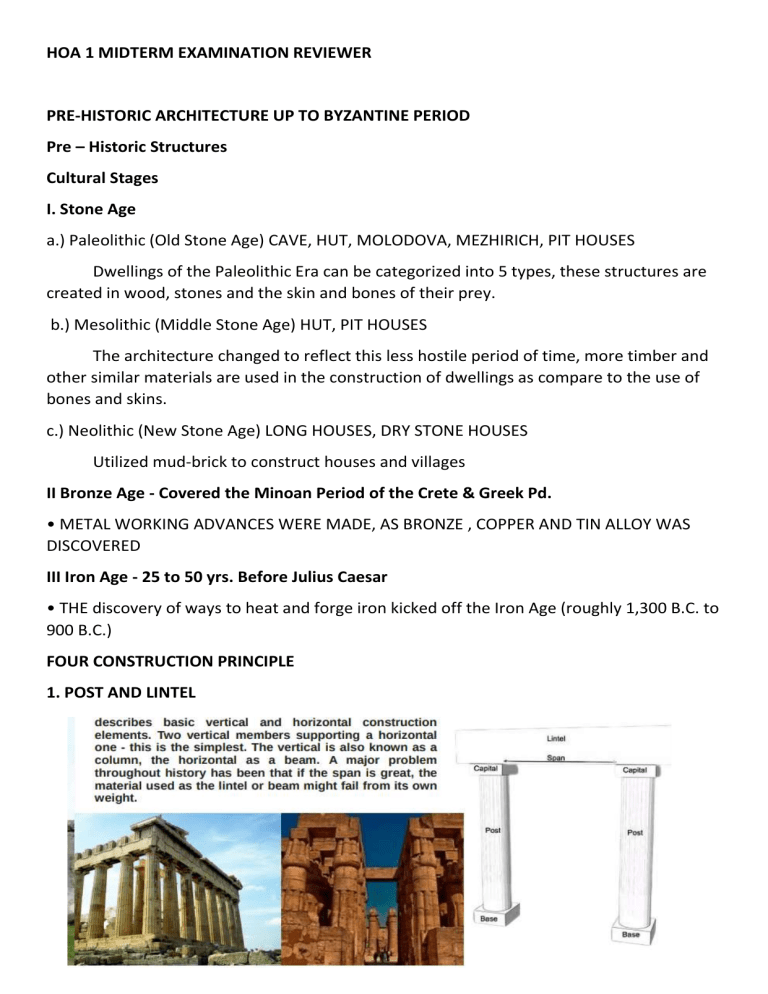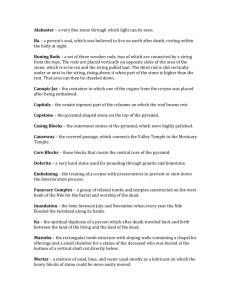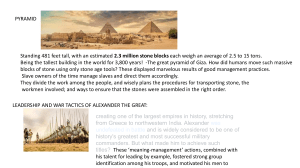HOA 1 Midterm Exam Reviewer: Prehistoric to Byzantine Architecture
advertisement

HOA 1 MIDTERM EXAMINATION REVIEWER PRE-HISTORIC ARCHITECTURE UP TO BYZANTINE PERIOD Pre – Historic Structures Cultural Stages I. Stone Age a.) Paleolithic (Old Stone Age) CAVE, HUT, MOLODOVA, MEZHIRICH, PIT HOUSES Dwellings of the Paleolithic Era can be categorized into 5 types, these structures are created in wood, stones and the skin and bones of their prey. b.) Mesolithic (Middle Stone Age) HUT, PIT HOUSES The architecture changed to reflect this less hostile period of time, more timber and other similar materials are used in the construction of dwellings as compare to the use of bones and skins. c.) Neolithic (New Stone Age) LONG HOUSES, DRY STONE HOUSES Utilized mud-brick to construct houses and villages II Bronze Age - Covered the Minoan Period of the Crete & Greek Pd. • METAL WORKING ADVANCES WERE MADE, AS BRONZE , COPPER AND TIN ALLOY WAS DISCOVERED III Iron Age - 25 to 50 yrs. Before Julius Caesar • THE discovery of ways to heat and forge iron kicked off the Iron Age (roughly 1,300 B.C. to 900 B.C.) FOUR CONSTRUCTION PRINCIPLE 1. POST AND LINTEL 2. ARCH AND VAULT 3. CORBEL AND CANILLEVER 4.TRUSSES 3 Classifications of early known types of Architecture Dwellings Structures A. Rock Cave – Earliest form of dwellings 3 Stages of the evolution of cave a. Natural cave b. Artificial cave c. Cave above the ground B. Tents and Huts – Made from tree barks, Animal skins and Plant leaves. Huts – usually made up of reeds, brushes and wattles. TEEPEE - CONICAL TENT WITH WOODEN POLES AS FRAMEWORK ANIMAL SKINS WERE USED TO COVER DOORS. BEEHIVE HUT - PRIMITIVE TYPE OF RESIDENCE DESIGNED BY ENLARGING A SIMPLE STONE HEMISPHERE. Religious Monuments 2 Classifications of Religious Structures a. Monolith – isolated single upright stone also known as “menhir” [Menhir - memorial of victory over one tribe b. Megalithic – Several number of stones Dolmen - 2 or more upright stones supporting a horizontal slab. Cromlech – 3 or more upright stones capped by an unchain flat stone. Stone Circle or Stone Row - made up of 3,000 stones spaced upright Burial Mounds Tumuli or “Barrows” – earthen mounds use for burials of several to couple hundreds of ordinary persons. Elements of Classical Supports 1. Basic Forms a.) pier b.) column c.) pilaster d.) pedestal e.) engaged column f.) baluster 2. Special Form a.) Caryatids -draped female figure without hands and carrying nothing. b.) Canephorae - same as caryatids but this time with basket on her head. c.) d.) e.) Atlas or Atlantes – male figure in kneeling position supporting the world at his shoulders. Telamon or Telamones – male figure in standing position in place of a column. Anta Column -- pier or pilaster formed by a thickening at the end of the wall. Classical Orders Orders – it includes the column (capital, shaft, base) with an entablature, which is following a certain rule with regards to systems of designing from Greece; a. Doric order – the simplest, earliest and the most perfect among the orders, made up of wood. a. Ionic order -- the most sophisticated, less heavy than the Doric order. b. Corinthian order -- the slenderest, elegant, and the most elaborated order. from Rome c. Composite order -- roman elaboration of the Corinthian order. d. Tuscan order -- the simplified version of the roman Doric order and has no shaft flutes. Superimposition or Super columniation -- the placing of one order after another or above another. Intercolumniation -- the clear space between two adjacent columns usually measured at the lower parts of the shafts. Arcade – a line of counterthrusting arches raised on columns of piers. A. GEOGRAPHICAL INFLUENCE EGYPT known as “The Land of Pharaoh “, & “desert Land “ The “Nile River” is their means of communication, highway, & lifeline. B. GEOLOGICAL INFLUENCE Stone – abundant building material except on temples and pyramids. Soft stone - limestone, sandstone, alabaster. Hard stone – granite, quartzite, basalt, porphyry Sand Dried Bricks – made up of clay and chopped stone for pyramids and temples. Mud Bricks- for houses Date Palm – for roofing’s Palm Leaves – for roofing materials. Acacia – for their boat Sycamore – mummy cases Reeds and Papyrus C. CLIMATIC INFLUENCE Structure have no downspout, drainage, gutters due to absence of rain. No windows to cut heat penetration and sandstorm. D. RELIGIOUS INFLUENCE Pyramids were built because they believe in “Life after Death “and for the preservation of the dead body. Different Egyptian gods: a. Amun—ra: chief god b.Rah : symbol of the sun , hope for eternal life , sun god from Heliopolis c. Atum : world creator d. Osiris : god of the dead e. Isis : wife of Osiris f. Horus : sky god, son of osiris, also reincarnation of “ ra” himself g. Set : dread god of evil, brother of pleasure h. Thot : ibis headed god of wisdom i. Anubis : jackal headed god of death j. Ptah : god of craftsmen k. Serapis : bull god E. HISTORY 30 Dynasties – started from 3rd Millennium B.C. to Roman Period. 1. Ancient Kingdom (1ST – 10th Dynasty) Development of two types of tombs a. Mastaba - was built above a burial tomb and contained a chapel and statue of the dead b. Pyramid - evolved from mastaba; with four sides facing the cardinal points, they were made by 100,000 men for 100 years. 2. Middle Kingdom -(11th-17th dynasty) Important Personalities: Mentuhetep II - developed the third type of tomb, the "rock-cut" type of tomb Senusrets - erected the earliest known Obelisk at Amenemhat I - founded the Great Temple at Kharnak Ammon Heliopolis and the Great Temple of 3. New Empire (18th-30th Dynasties) Important Personalities: Thotmes - began the additions to the Temple of Ammon, Kharnak; the first pharaoh to be buried in the rock-cut, Tomb of the Kings in Thebes Hatshepsut - Queen of Egypt, famous for her funerary temple at the Mountain Der-El-Bahari Thotmes IV -known as the one responsible for cleaning away of sand from the famous sphinx Amenophis III -erected the renowned "Colossi of Memnon," one of the wonders of the world Rameses I - began the construction of the "Great Hypostyle Hall" at Karnak Rameses II -finished the structure of the Hypostyle Hall, Karnak erected the Rock Temple at Abu Simbel and the Ramessium, Thebes. and also 4. Ptolemaic Period Important Personalities: Ptolemy II - built the Pharaohs or the "Light House," one of the wonders of the world⁹ Ptolemy III -founded the Great Serapeum at Alexandria F. SOCIAL AND POLITICAL INFLUENCE • Monarchy - a form of government • Pharaoh - King of Egypt, ruler, the highest priest in Egypt • Son of Pharaoh - the standard successor to the throne Vizier - King's most powerful official • Chancellor - controls the royal treasuries, granaries and supervises the census • Chief Steward - in charge of the King's estate and household • Social Ranks • 1. Noble families - royal throne with his family • 2. Soldiers, Viziers, Chancellors, Chief Stewards • 3. Fishermen, Farmers, Craftsmen, Merchants, Ordinary Egyptians • 4. Slaves - the lowest form • SPHINX • In ancient Egypt, the sphinx was a spiritual guardian and most often depicted as a male with a pharaoh headdress—as is the Great Sphinx—and figures of the creatures were often included in tomb and temple complexes. G. ARCHITECTURAL CHARACTER a. Simplicity b. Monumentality c. Solidity or Massiveness H. SYSTEMS OF CONSTRUCTION a. Post and Lintel b. Columnar or Trabeated Features of Egyptian Architecture a. Batter Wall- inclination from base to top of the façade. b. Hieroglyphics- use as ornaments, pictures and writings from the walls. I. STRUCTURES 1. TOMBS (3 TYPES) A. Mastaba - flat top or tapered solid temple. 3 Important Parts of Mastaba a. Outer Chamber- where offerings were placed. b. Serdab – inner chamber containing the statues of the deceased member of the family c. Sarcophagus – chamber containing the “coffin” reached by an underground shaft. B.Pyramids – evolved from mastaba; with four sides facing the cardinal points, they were made by 100,000 men for 100 years. Step Pyramid Pyramid of King Zoser or Iser – built by Imhotep, oldest surviving masonry building structure in the world. Bent or Blunt Pyramid – 2 degrees of inclination of slope e.g. Pyramid of Seneferu Slope Pyramid – parts (king’s chamber, Queen’s chamber, subterranean chamber, grand gallery, airshafts. e.g. 3 Famous Pyramid at Gizeh. Great Pyramid of the Cheops was equated to the size of St. Peter Rome. Pyramid of the Cheops or Khufu (146.4 mts. high & (750 sq. ft.) in plan two times the area of the famous “St. Peter Basilica in Rome”. Pyramid of Cheops or “Khafra” (143.0 mts. high) & (705 sq. ft.) in plan. Pyramid of Mykerinos or “Menkaura “(109.0 mts. high) and (218 ft. high) Parts of Pyramid Complex: a. elevated causeway b. offering chapel c. mortuary d. valley bldg. C. Rock Cut Tomb or Rock Hewn Tomb – cut deep into the mountain rock e. g. Tombs of the kings, Thebes 2. TEMPLES-they were sanctuaries that only kings and priests can penetrate. 2 types 25 a. Mortuary – built in honor of the pharaohs b. Cult – built for the worship of the gods, only high priest can enter in both types of temple. Parts of an Egyptian Temple: a. Entrance Pylon – massive sloping towers fronted by an obelisks known as gateways in Egypt. b. Hypaethral Court – large outer court open to the sky c. Hypostyle Hall - a pillared hall in which the roofs rest on column. d. Sanctuary – usually surrounded by passages & chambers used in connection w/ the temple service. 26 e. Avenue of Sphinx – where mystical monsters were placed. Example of temples a. Great Temple of Abu – Simbel – entrance forecourt leads to an imposing façade formed by a pylon carved with 4 Colossal seated statues. (Ramesses 1-1V) b. Great Temple of Ammon, Kharnak – grandest temple in Egyptian planning and was commenced by Amenemhat 1; occupying an area of 1,200 ft. x 360 ft. c. The Great Temple of Abu- Simbel it is one of the rock- hewn temples at this place commanded by the indefatigable Rameses II. An entrance forecourt leads to the imposing façade, 36 m (119 ft.) wide and 32 m (105 ft.) high formed as pylon, immediately in front of which are four rock-cut seated colossal statues of Rameses, over 20 m (65 ft.) high. d. Temple of Queen Hatshepsut, Mt. Der – El - Bahari Queen of Egypt, famous for her funerary temple at Mt. Der-El-Bahari. 3. OBELISKS – are monumental pillars usually in pairs at the temple entrances considered the symbol of “Heliopolis” the sun god. They are square in plan & stands at the ht. of 9 to 10 times the diameter of the base. The four sides taper to the top on the form of a small pyramid. e.g. Cleopatra’s Needle, Embankment, London Piazza of St. John Laterano, Rome. 4. SPHINX– a mystical monster with a body of a lion and head of a man or “androsphinx”, body of a lion & head of a hawk or “heiraosphinx “, & body lion & head of a ram or “criosphinx”. e.g. Great Sphinx at Gizeh near the Pyramid of the Cheops. J. CAPITALS & COLUMNS a.) Bud & Bell Capital e.) Palm type Capital b.) Polygonal Columns f.) Square Pillars c.) Papyrus Capital g.) Hathor – Headed Capital d.) Volute Capital h.) Osiris Pillars K. MOULDINGS a. Gorge and Hollow b. Torus L. ORNAMENTS / FINISH Torus and Cavetto/ Gorge Cornice Hieroglyphics use as ornaments, pictures, and writing from the walls. a. Lotus, papyrus, and palm-symbolizes fertility b. Scarab or sacred beetle-symbolizes resurrection c. Solar discs and vultures with wings-symbolizes protection d. Spiral and feather ornament-symbolizes eternity M. ARCHITECTURAL CHARACTER A. GEOGRAPHICAL INFLUENCE THE LOCATION OF THE CITY OR OF A PARTICULAR COUNTRY. IY DESCRIBES WHETHER IT IS NEAR THE SEA, AN ISLAND West Asiatic Architecture flourished & developed in the Twin Rivers “Tigris and Euphrates also known as “Mesopotamia” it refers to Persia, Assyria and Babylon. B. GEOLOGICAL INFLUENCE THE MATERIAL FOUND IN THE LOCALITY, THE CHARACTER AND THE COMPOSITION OF THE LAND AND THE COUNTOUR OF THE GROUND Due to floods & heavy rains, it resulted in the conversion of its earthen into clay to produce “bricks” in Assyria and Babylon, due to rare experience of rain in Persia, they use timber and colored limestone. C. CLIMATIC INFLUENCE THE PREVAILING WEATHER IN THE COUNTRY Mesopotamia experience floods and heavy rains which have resulted in the building of “Ziggurats “in Persia, they have dry and hot climate which resulted in building open type temples. D. RELIGIOUS INFLUENCE THE EMOTIONAL TEMPERAMENT AND SPIRITUAL TENDENCIES OF THE PEOPLE IN A PARTICULAR COUNTRY Mesopotamians were superstitious, believers of symbolism and also believers of genies and demons E. SOCIAL & POLITICAL INFLUENCE THE LIFESTYLE OR WAY OF LIVING OF PEOPLE IN THE COUNTRY AND THEIR FORM OF GOVERNMENT Babylonians among the three were considered extraordinary because they achieved highest degree of civilization F. HISTORICAL INFLUENCE THE BACKGROUND OF PEOPLE AS A WHOLE a. Babylonian Period. b. Assyrian Pd. c. Neo -Babylonian Pd. d. Persian Pd. G. ARCHITECTURAL CHARACTER a. Massiveness b. Monumentality c. Grandeur Persian Architecture: a. Columnar and Trabeated with flat timber roof sometimes domed. Assyrian and Babylonian Architecture: a. Arcuated type of construction b. Arch, vault and flat strips, buttresses with glazed tile adornment. A. STRUCTURES Babylonian Architecture: 1. Ziggurats or “Holy Mountains”– chief building structure, square or rectangle in plan with steeply battered sides and an open flat form on top containing the “Fire Altar “. Three types of Ziggurats: a. Archaic ziggurat – usually have one flat top rectangular mound carrying the upper temple. e.g. White Temple at Warka b. Two or more stages Ziggurat –rectangular in plan, design with several tiers or stages. e.g. The ziggurat, Nimrod Tower of Babel Ziggurat at Bursippa Seven stage pyramid dedicated to seven heavenly planets 2. City of Babylon – with towers & 100 Bronze Gates Assyrian Architecture: 1. Palace of Sargon, Khorbad – entrance portals flanked with status of headed winged bulls and lions. It contains 700 rooms. Important parts of Palace a. Seraglio – palace proper which includes the king’s residence, men’s apartment and reception courts. b. Harem - usually designed with a private family apartments or women’s quarter. c. Khan - or service chambers, Khan is a Moslem “inn”, for traveler’s prototype Persian Architecture 1. Palace Flatform Persepolis- occupies 1500 and 1000 ft. and is elevated 40 ft. It contains the following: a. Palace of Darius b. Hypostyle Hall of Xerxes c. Palace of Xerxes d. Halls of Hundreds columns e. Propylaea – entrance to hall design by Xerxes H. COMPARATIVE ANALYSIS a. Plan: Babylonian palaces and temples were built on artificial flatforms 30feet above the plain, b. Walls: Babylonian walls are normally made-up of sun-dried bricks faced with kilnburnt. Assyrian walls are also made-up of sun-dried bricks finished with polychrome. Persian walls are also made of bricks and followed the Assyrian style. c. Openings: Babylonian and Assyrian doors are usually spanned by semi-circular. Persian doors are spanned by lintels, and used of monster prior to doorways d. Windows: Babylonian and Assyrian windows are not in use. Persian windows are also spanned by lintels. e. Roofs: Generally, roofs are flat externally and also in some cases, tunnel vaults and domes are used. f. Columns: Babylonians and Assyrians have no columns. Persian column features, high molded base, fluted shafts, bracket form of topmost capitals was of “twin bulls “, “dragons “, or sometimes “human heads “. g. Mouldings: Babylonian and Assyrian mouldings were of little use. Persian adopted mouldings from the Egyptians. h. Ornaments: Assyrian and Persian ornaments they have the monster planking entrance portals mural decoration by polychrome bricks of blue, yellow and green with low relief stabs.



